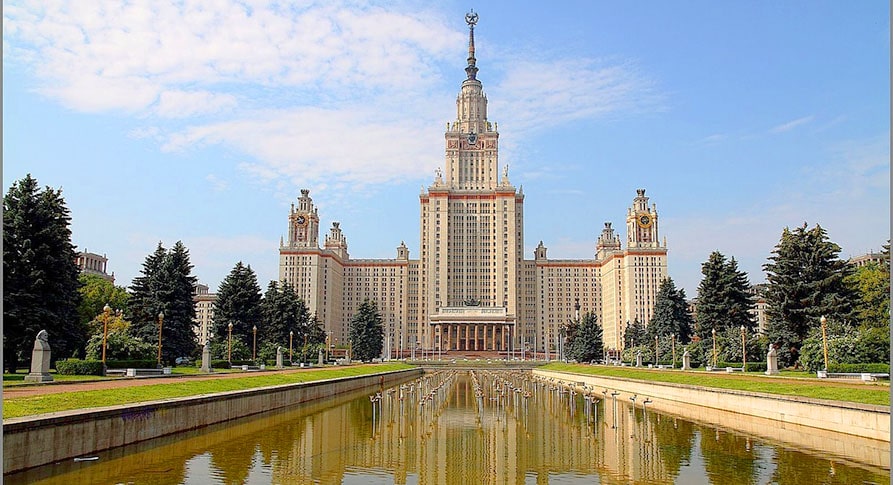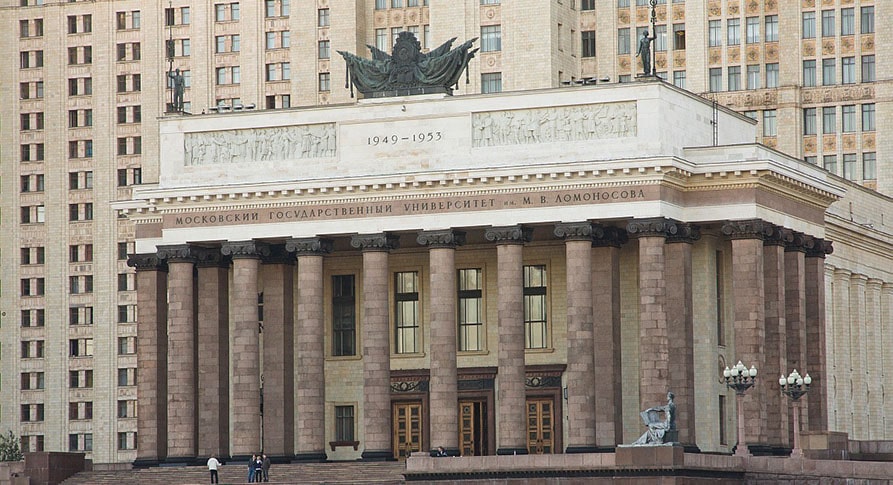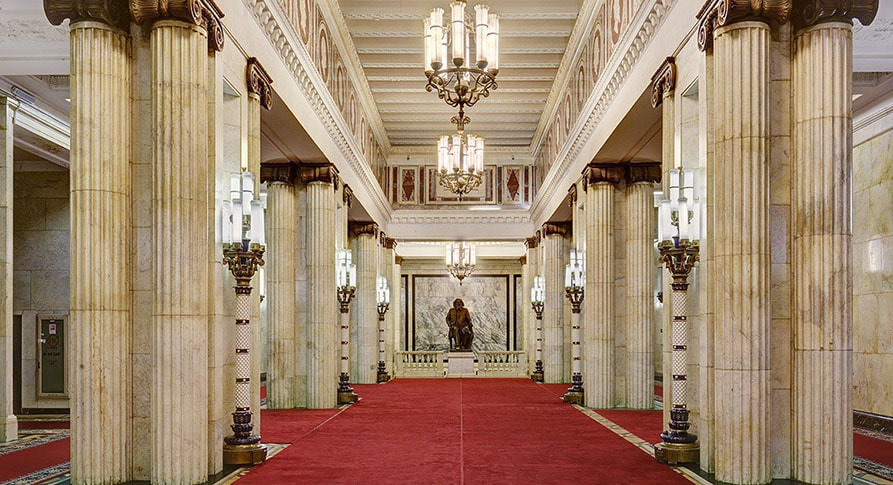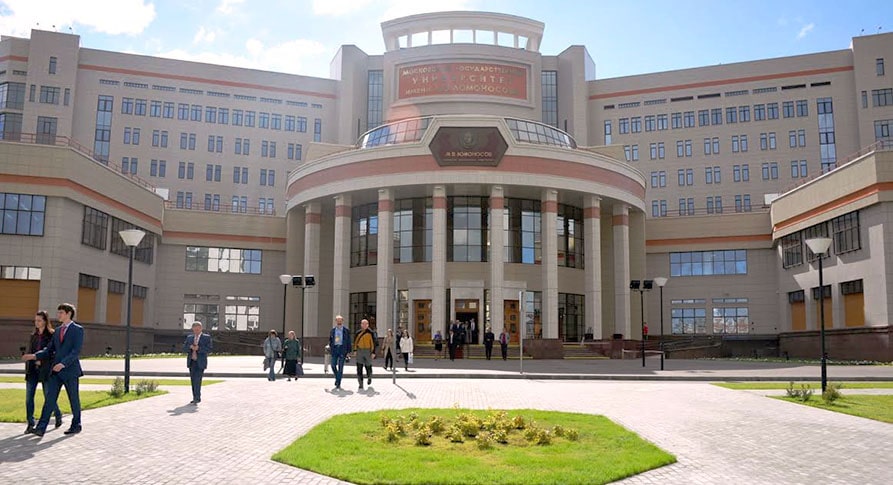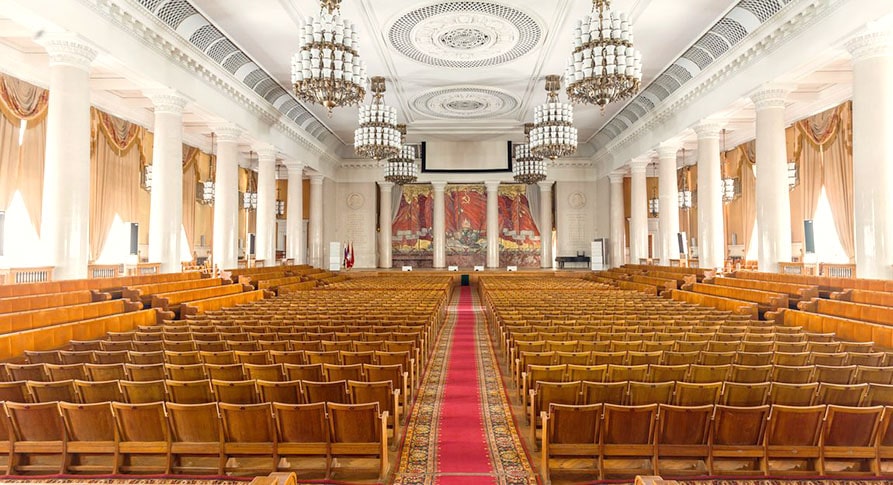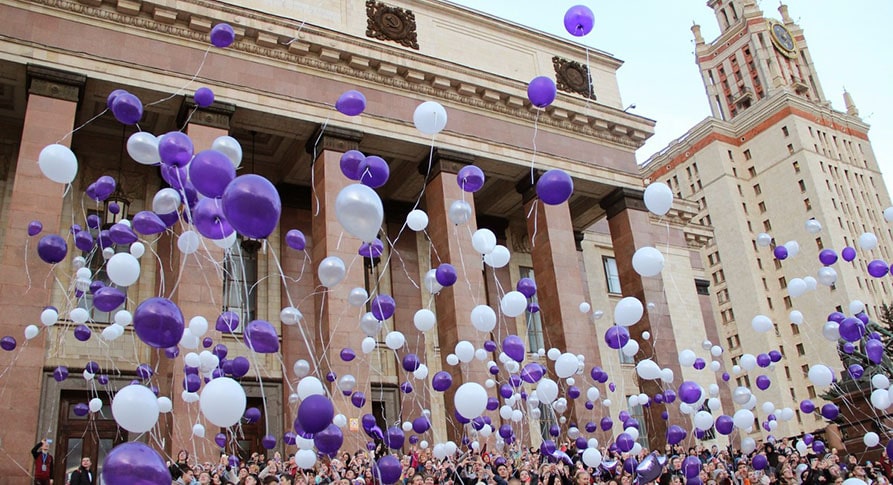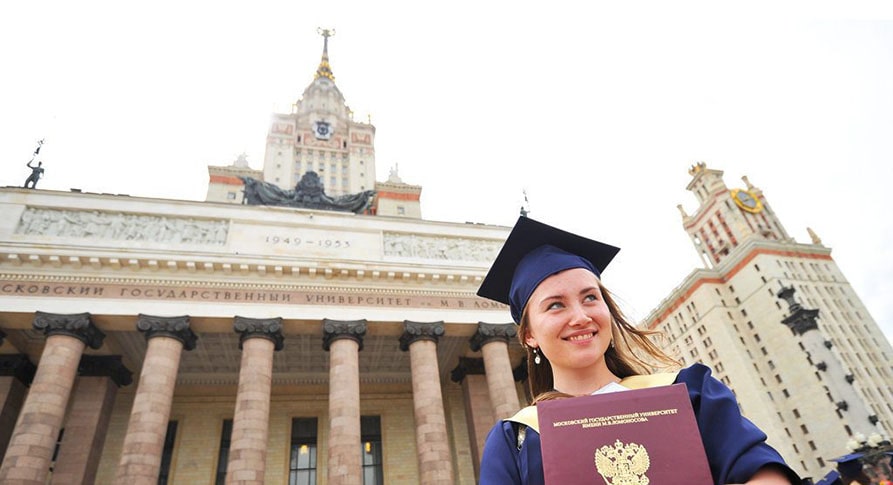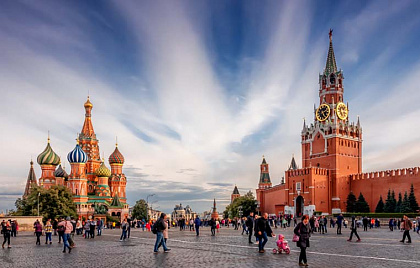Moscow State University
city
Moscow / Russia
Russian Hogwarts (Academy of Witchcraft and Wizardry) - that's what the colossus of the officially named M.V. Lomonosov Moscow State University (MSU) is! Truly, the grandeur of its sensational gargantuan Main Building is rivaled only by its great prestige, both local and international, with 11 Nobel prizes among its graduates and professors.
The looming edifice of the University at its cloud-slicing 240 meters on the summit of Vorobyevy Gory (Sparrow Hills) is a prominent fixture in Moscow’s skyline and the world famous symbol of Russia’s capital.
Even if you have never been to Moscow, you might have already seen this mega structure in case you watched programs from FIFA Fan Fest during the World Cup 2018. The spacious square in front of the University overlooking the Moskva River and Luzhniki stadium was a busy fan zone, and a huge screen was placed on the facade of the MSU building for live broadcasting of all matches.
The University is the most famous construction among the fabled Seven Sisters family of high-rises commissioned by Joseph Stalin and erected between 1947 and 1953 to commemorate the 8th Centennial of the city founded in 1147. In the aftermath of World War II this ambitious skyscrapers project had to be a testament to Russia's dramatic postwar renovation and send a clear message to western world that the U.S.S.R. had not been "bled white" in the battle against Nazism but like Phoenix rose from the ashes in full of its might and glory! And certainly, the Soviet people, who paid such a high price for the great victory in that terrible war, deserved their SLICE OF THE SKY!
Stalin’s penchant for Gothic architecture resulted in the spiky silhouettes of the “Sisters”. They showcase an amazing combination of the Russian Baroque, Gothic and Neoclassical styles with influences from the New York skyscrapers of the 30s as well as a wide palette of Soviet Realism. The architects settled on a terrace-like or tiered construction, often referred to as a "wedding-cake" style, to give each building a sense of "upward surge" toward a central tower.
There're also many people who believe that Uncle Joe, being not indifferent to mysticism, conceived gigantic structures as real Soviet ziggurats - pyramids, featuring special supernatural properties. True or false? Who knows? One thing seems obvious: unparalleled in their colossal scale and glorification of the bygone totalitarian Soviet state, these imposing high-rises dominate urban landscape, still capable either to inspire dreams of imperial grandeur, or resurrect ghosts of dark abuses of power.
If you leave behind the MSU Main Building and come up to the edge of the viewpoint on Vorobyevy Gory (Sparrow Hills), the tallest city spot of 80m above the Moskva River that offers unbeatable panorama, you can see 4 or 5 of other Stalin’s Sisters skyscrapers. Besides the University, the family includes:
- 2 apartment houses, "cities within a city" which were once the home to elites: Communist bureaucrats and state figures, space scientists, members of the military establishment and secret police, outstanding creatives and other stars of the Soviet world;
- 2 hotels: Ukraina, a five-star accommodation, known today as the Radisson Royal Hotel, and Leningradskaya, four-star, now a part of the Hilton Hotel chain;
- 2 government offices: The Ministry of Foreign Affairs and Ministry of Railways.
From miles around, these grandiose structures, their silhouettes, their spires stand out on the Moscow scenery. In defiance of the growing competition from the current building boom, they are still amongst some of the tallest buildings in Europe and remain the definitive architectural statement of the Moscow’s contemporary identity.
But back to the Moscow State University, which is named after Mikhail Lomonosov, great Russian scientist, polymath who founded the country’s first institution of higher education in 1755. The gorgeous MSU Main Building is the first and the biggest construction of the Stalin’s Sisters. It was started in 1949 and completed in 1953, in an area of about 187 hectares, its massive dimensions ensure that a walk around the perimeter lasts for 3 km. The primary structure - basement and skeleton - was developed by the creator of the Ostankino TV tower Nikolai Nikitin. In total, more than 400 architects worked on the project. The main tower consumed over 40,000 metric tons of steel alone.
The 36-storey-high main tower is topped by a 12-ton star large enough to include a small room and a viewing platform. The communication equipment and powerful emitters are installed along the entire length of the spire. In the facades, you can appreciate the symbols of the era, such as the Soviet star, Hammer & Sickle and varied sculptures and ornaments, like carved wheat sheaves – symbols of prosperity and grandeur of the life of Soviet people. The clock of University building is one of the biggest in Europe. Its minute hand is twice longer than the one of the Kremlin Clock and weighs 39 kilos, while the hour hand is even heavier - 50 kilos! The giant edifice features 35km of corridors, over 5000 rooms and 111 elevators. It’s amazing that operation of the elevators resembles the Moscow metro: most of them run up to just a certain floor, and then you have to "make transfer" to go higher!
After the construction was completed, for almost 40 years it was the tallest structure in Europe.
“The father of the nation” did not live only six months to the grand opening on September 1, 1953.
Till now, the University Main Building is a record holder for the number of secrets and legends it preserves.
One of these tells that because of the soft ground of Vorobyovy Gory (Sparrow Hills), the basement of the structure was allegedly filled with liquid nitrogen, and giant cryo facilities were installed. If one day the system fails and thousands of cubic meters of soil unfreeze, then one of the symbols of the capital will end up in the Moscow River and will float away to some other city…
There is a legend about a five-meter golden statue of Uncle Joe hidden "somewhere in the basements", which was supposed to stand in front of the building instead of the monument to Lomonosov, but vanished after the death of the leader.
Another “apocryphal” story claims that the building runs as deep underground as it did above, forming the entire hidden city and concealing secret research centers and a maze of tunnels leading directly to Stalin’s personal country house (dacha).
Legends aside, in the 1950s, according to historians, the KGB offices could be located in the spire. From such a height, a wide panorama of the city opened up and even Stalin's dacha in Kuntsevo suburb could be seen - so they were able to keep a lookout from this skyscraper.
For some students and professors, the MSU Main Building is not only a place of study or work, but also their home. The side wings of the edifice house residential premises and all necessary infrastructure facilities: classrooms, dormitories, canteens, a concert hall, a theatre, a museum, various administrative services, a library, a stadium, a swimming pool, a polyclinic, a police station, a post office, a laundry, a hairdresser’s salon, bank offices and ATMs, shops, cafeterias, a bomb shelter, etc. Theoretically, a student may stay in his alma mater without leaving the Main Building during the entire academic year. That’s just an idea, however, it is known for sure that in the 50s, in winter many students did not leave the place because of lack of warm clothes.
Many decades have passed since then, nowadays the MSU features around 40 faculties with 45,000 students. The Moscow University became alma mater for thousands and thousands of boys and girls from different parts of Russia and all over the world. It is justly regarded as symbol of friendship and fraternity of democratic youth of all countries and peoples.
Today Moscow is a city of impetuous development, as new steel-and-glass office buildings pop up with growing frequency. But none has challenged the distinctive imprint of these seven high-rises on the capital's contemporary skyline.
And there’s no wonder that the logo (insignia) of the Moscow Olympic Games of 1980 was largely inspired by the majestic soaring skyward silhouette of the Moscow University.
Gazing on it, we seem to hear the proud words of our former national anthem:
United forever in friendship and labour,
Our mighty republics will ever endure.
The Great Soviet Union will live through the ages.
The dream of a people their fortress secure.
The looming edifice of the University at its cloud-slicing 240 meters on the summit of Vorobyevy Gory (Sparrow Hills) is a prominent fixture in Moscow’s skyline and the world famous symbol of Russia’s capital.
Even if you have never been to Moscow, you might have already seen this mega structure in case you watched programs from FIFA Fan Fest during the World Cup 2018. The spacious square in front of the University overlooking the Moskva River and Luzhniki stadium was a busy fan zone, and a huge screen was placed on the facade of the MSU building for live broadcasting of all matches.
The University is the most famous construction among the fabled Seven Sisters family of high-rises commissioned by Joseph Stalin and erected between 1947 and 1953 to commemorate the 8th Centennial of the city founded in 1147. In the aftermath of World War II this ambitious skyscrapers project had to be a testament to Russia's dramatic postwar renovation and send a clear message to western world that the U.S.S.R. had not been "bled white" in the battle against Nazism but like Phoenix rose from the ashes in full of its might and glory! And certainly, the Soviet people, who paid such a high price for the great victory in that terrible war, deserved their SLICE OF THE SKY!
Stalin’s penchant for Gothic architecture resulted in the spiky silhouettes of the “Sisters”. They showcase an amazing combination of the Russian Baroque, Gothic and Neoclassical styles with influences from the New York skyscrapers of the 30s as well as a wide palette of Soviet Realism. The architects settled on a terrace-like or tiered construction, often referred to as a "wedding-cake" style, to give each building a sense of "upward surge" toward a central tower.
There're also many people who believe that Uncle Joe, being not indifferent to mysticism, conceived gigantic structures as real Soviet ziggurats - pyramids, featuring special supernatural properties. True or false? Who knows? One thing seems obvious: unparalleled in their colossal scale and glorification of the bygone totalitarian Soviet state, these imposing high-rises dominate urban landscape, still capable either to inspire dreams of imperial grandeur, or resurrect ghosts of dark abuses of power.
If you leave behind the MSU Main Building and come up to the edge of the viewpoint on Vorobyevy Gory (Sparrow Hills), the tallest city spot of 80m above the Moskva River that offers unbeatable panorama, you can see 4 or 5 of other Stalin’s Sisters skyscrapers. Besides the University, the family includes:
- 2 apartment houses, "cities within a city" which were once the home to elites: Communist bureaucrats and state figures, space scientists, members of the military establishment and secret police, outstanding creatives and other stars of the Soviet world;
- 2 hotels: Ukraina, a five-star accommodation, known today as the Radisson Royal Hotel, and Leningradskaya, four-star, now a part of the Hilton Hotel chain;
- 2 government offices: The Ministry of Foreign Affairs and Ministry of Railways.
From miles around, these grandiose structures, their silhouettes, their spires stand out on the Moscow scenery. In defiance of the growing competition from the current building boom, they are still amongst some of the tallest buildings in Europe and remain the definitive architectural statement of the Moscow’s contemporary identity.
But back to the Moscow State University, which is named after Mikhail Lomonosov, great Russian scientist, polymath who founded the country’s first institution of higher education in 1755. The gorgeous MSU Main Building is the first and the biggest construction of the Stalin’s Sisters. It was started in 1949 and completed in 1953, in an area of about 187 hectares, its massive dimensions ensure that a walk around the perimeter lasts for 3 km. The primary structure - basement and skeleton - was developed by the creator of the Ostankino TV tower Nikolai Nikitin. In total, more than 400 architects worked on the project. The main tower consumed over 40,000 metric tons of steel alone.
The 36-storey-high main tower is topped by a 12-ton star large enough to include a small room and a viewing platform. The communication equipment and powerful emitters are installed along the entire length of the spire. In the facades, you can appreciate the symbols of the era, such as the Soviet star, Hammer & Sickle and varied sculptures and ornaments, like carved wheat sheaves – symbols of prosperity and grandeur of the life of Soviet people. The clock of University building is one of the biggest in Europe. Its minute hand is twice longer than the one of the Kremlin Clock and weighs 39 kilos, while the hour hand is even heavier - 50 kilos! The giant edifice features 35km of corridors, over 5000 rooms and 111 elevators. It’s amazing that operation of the elevators resembles the Moscow metro: most of them run up to just a certain floor, and then you have to "make transfer" to go higher!
After the construction was completed, for almost 40 years it was the tallest structure in Europe.
“The father of the nation” did not live only six months to the grand opening on September 1, 1953.
Till now, the University Main Building is a record holder for the number of secrets and legends it preserves.
One of these tells that because of the soft ground of Vorobyovy Gory (Sparrow Hills), the basement of the structure was allegedly filled with liquid nitrogen, and giant cryo facilities were installed. If one day the system fails and thousands of cubic meters of soil unfreeze, then one of the symbols of the capital will end up in the Moscow River and will float away to some other city…
There is a legend about a five-meter golden statue of Uncle Joe hidden "somewhere in the basements", which was supposed to stand in front of the building instead of the monument to Lomonosov, but vanished after the death of the leader.
Another “apocryphal” story claims that the building runs as deep underground as it did above, forming the entire hidden city and concealing secret research centers and a maze of tunnels leading directly to Stalin’s personal country house (dacha).
Legends aside, in the 1950s, according to historians, the KGB offices could be located in the spire. From such a height, a wide panorama of the city opened up and even Stalin's dacha in Kuntsevo suburb could be seen - so they were able to keep a lookout from this skyscraper.
For some students and professors, the MSU Main Building is not only a place of study or work, but also their home. The side wings of the edifice house residential premises and all necessary infrastructure facilities: classrooms, dormitories, canteens, a concert hall, a theatre, a museum, various administrative services, a library, a stadium, a swimming pool, a polyclinic, a police station, a post office, a laundry, a hairdresser’s salon, bank offices and ATMs, shops, cafeterias, a bomb shelter, etc. Theoretically, a student may stay in his alma mater without leaving the Main Building during the entire academic year. That’s just an idea, however, it is known for sure that in the 50s, in winter many students did not leave the place because of lack of warm clothes.
Many decades have passed since then, nowadays the MSU features around 40 faculties with 45,000 students. The Moscow University became alma mater for thousands and thousands of boys and girls from different parts of Russia and all over the world. It is justly regarded as symbol of friendship and fraternity of democratic youth of all countries and peoples.
Today Moscow is a city of impetuous development, as new steel-and-glass office buildings pop up with growing frequency. But none has challenged the distinctive imprint of these seven high-rises on the capital's contemporary skyline.
And there’s no wonder that the logo (insignia) of the Moscow Olympic Games of 1980 was largely inspired by the majestic soaring skyward silhouette of the Moscow University.
Gazing on it, we seem to hear the proud words of our former national anthem:
United forever in friendship and labour,
Our mighty republics will ever endure.
The Great Soviet Union will live through the ages.
The dream of a people their fortress secure.
city
Moscow / Russia

